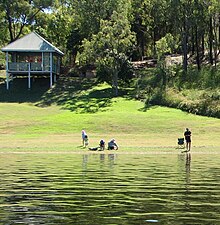Lake Awoonga
The Lake Awoonga is a reservoir in the east of the Australian state of Queensland. The lake was created by constructing a dam on the Boyne River 30 km south of Gladstone (Queensland ).
Purpose
The Lake Awoonga is the main water tank of the Gladstone Region. The Gladstone Area Water Board operates the facility and has released it for residents and tourists for water sports and sport fishing.
Type
The Awoonga Dam is a gravity dam, which is heaped up from boulders and water- side with a concrete casing. The bed was created out of rocks from a quarry nearby. It is about 650 m long and 54.4 m high. Its volume is about 2 million cubic meters. The outlet is located at 40 m above sea level. The construction of the dam allows the current further lifting of the outlet, should this be necessary. The maximum storage capacity is currently 777 million cubic meters.
With full back-up of the water table is at 41 m above sea level.
Fauna
At Lake Awoonga, there are many small animals that need special protection, such as the Grey-headed flying fox and the Yellow-bellied gliders. The aquatic flora provides a range of prey for fish, eels, turtles, platypus and birds food. Other species are Australian bandicoots, rats red kangaroos, kangaroos, wallabies, and Riesengleitbeutler Fuchskusus.
Lakeside is home to over 225 species of birds, such as the letters dove, which is listed as endangered, and a further 27 species of birds from the International Migratory Conservation Agreement List.
Australian Water
Sichelpfeifgans
Hood Reads
Aquaculture and recreational fishing
Approximately 200,000 fish - even Barramundi and Mangrove Jack some ( Lutjanus argentimaculatus ) - are used annually in the lake. By early 2006, over 2.9 million fish in the Lake Awoonga were used, of which 2.4 million barramundi, 470,000 mullet and 15,000 Mangrove Jack. The biggest barramundi caught per there, was registered in November 2008 at 36.5 kg. The Lake Awoonga is one of the few lakes in Australia, which was equipped with Mangrove Jack.
Flora
More than 415 species of plants ensure a healthy development of the Lake Awoonga and its surroundings. The habitats include rain forests, as well as sparse forests and grass forests. There are 45 confirmed species of aquatic plants, such as hornworts and sour grass plants that are found in shallow water. Aquatic plants fulfill important tasks; they forage for animals, stabilize the river bed and degrade nutrients.
There are also a number of particularly sensitive plants in the Awoonga region, such as Persoonia amaliae and Eucalyptus melanoleuca, which are classified as rare, while Cycas megacarpa and Grevillea venusta are considered endangered. Banksia integrifolia and Xanthorrhoea latifolia are protected species, which one also finds in the area.
In the entire river system, there are also entrained plants and weeds that spread everywhere, eg Parthenium, floating ferns, cat's claw, lantana, oleander and Cryptostegia grandiflora. A program for the control of alien plant is designed to support of the annual weed control program.
The Gladstone Area Water Board has a planting program for the conservation of endangered regional ecosystems that have been damaged by the reservoir the system performed.
Recreational facilities
Swimming is allowed in the lake and there is a usable around the clock Slipway for boats, so sailing, fishing and water skiing are possible. Various watercraft, houseboats, you can rent. Similarly, there is tours for anglers. The water is controlled by the Queensland Boating and Fisheries Patrol and the water police and all boaters are encouraged to adhere to the prescribed speed limits.
The camping is permitted in two places at Lake Awoonga, the caravan park and the Boynedale Bush Camp. The main resort area is freely accessible to the public and has barbecue and picnic areas, and hiking trails.










